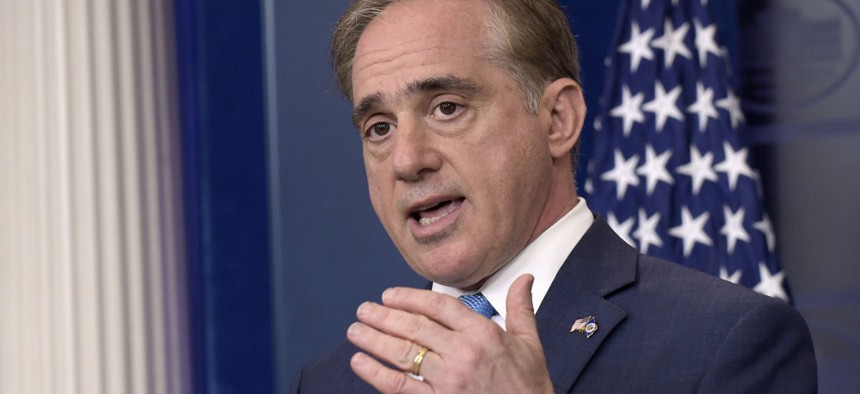
Veterans Affairs Secretary David Shulkin speaks during a briefing at the White House on Wednesday. AP Photo/Susan Walsh
VA Needs Greater Firing Power More Than a Larger Budget, Secretary Says
Shulkin continues the headquarters hiring freeze and praises Trump’s commitment to veterans.
Delivering a “State of the VA” address on his 100th day in office, Veterans Affairs Secretary Dr. David Shulkin on Wednesday laid out 13 “risk areas” that threaten progress at his agency, stressing the need for greater “accountability” in disciplining errant employees and a need to partner with the private sector to improve health care and modernize the VA’s legacy information technology.
When President Trump visited the VA on his own 100th day in office, Shulkin told reporters, “he told me how important it is to be open, candid and transparent about where the problems are.” Combining Trump’s business skills with his own skills as a doctor will be the focus of what he called “our commitment to fully addressing the problems that have plagued the VA for decades,” the secretary said.
The 13 risk areas, which were determined after analyzing 137 studies and reports, include such various things as veterans access to care, the quality of care, facilities planning, the backlog of disability claims and outdated technology. Such factors contributed to the now-notorious delays in scheduling medical appointments for veterans.
Both Trump and Vice President Mike Pence have been “extremely responsive” to the unfolding agenda, said Shulkin, an Obama administration holdover who was elevated to the top VA job in February.
The department’s agenda echoes the broader themes of the Trump administration, and includes reducing VA bureaucracy. “The central office has gotten too big and bureaucratic,” Shulkin said, which is why he is continuing a hiring freeze at headquarters and is implementing a shared services effort involving the VA’s 140 programs.
He also spoke of saving money by working around burdensome regulations, citing a switch to state rules on design of small houses for vets instead of federal ones, and using the American Cancer Society standards rather than federal standards for when women vets should undergo mammograms.
Ferreting out waste, fraud and abuse, Shulkin said, is a high priority. Already in fiscal 2016 the department has saved $27 million in prevented duplicative payments, he said.
Shulkin bemoaned that fact that 1,500 disciplinary cases that could result in firings, suspensions or demotions for employees who “violated core values” remain pending. He cited the recent case of a staff psychiatrist who watched pornography with a patient and is still on the payroll and the fact that last week the department was required to take back three employees who did jail time for drunk driving.
The department did remove the medical director at the troubled VA hospital in Washington and several poor performers in Shreveport, La., Shulkin said. Though a new VA Office of Accountability and Whistleblower Protection reports to him, new legislation is need on firing power, he said.
Hiring also remains an obstacle. It takes 110 days to hire a nurse and 177 for a nurse practitioner, Shulkin said, which compared with the private sector is too long. Salaries for biomedical engineers who design prosthetic limbs, for example, are $65,000 at VA but $85,000 in the private sector. He is pursuing legislation to allow more graduate medical students to work with VA.
Addressing capital assets and construction needs, Shulkin cited an $18 billion National Infrastructure Strategy to address the fact that the average VA building is more than six decades old. A startling 449 buildings date from the Revolutionary War and Civil War, of which 96 are vacant, while 591 were built during World War I, of which 141 are vacant.
Other goals include improving medical payment processing times, advancing electronic health records, making it easier for vets to check their claims online, addressing 10 percent of community care centers that don’t offer same-day medical appointments, and helping the 14 VA medical centers deemed to be failing, based on VA’s rating system.
His top clinical priority, he said, is “getting to zero” with a program due this summer for preventing veterans suicide, which afflicts 20 vets a day, he noted.
Trump’s fiscal 2018 budget, which gives VA a 5.5 percent increase over 2017 spending—despite some cuts to unemployment insurance—addresses what’s needed, Shulkin said. “The problems at VA won’t be solved through additional money,” but through better management and legislation. The exception, he said, is modernization of the department’s information technology infrastructure.
Nor do his reforms amount to a desire for privatization. “The wait times issue shows that we can’t do this alone—we need to work with the private sector,” Shulkin said. The veterans choice program—which expires this year and needs reform, he added--is not a privatization or a diluting of VA. “America needs a strong VA.”
NEXT STORY: The Tough-Love Approach to Career Guidance







